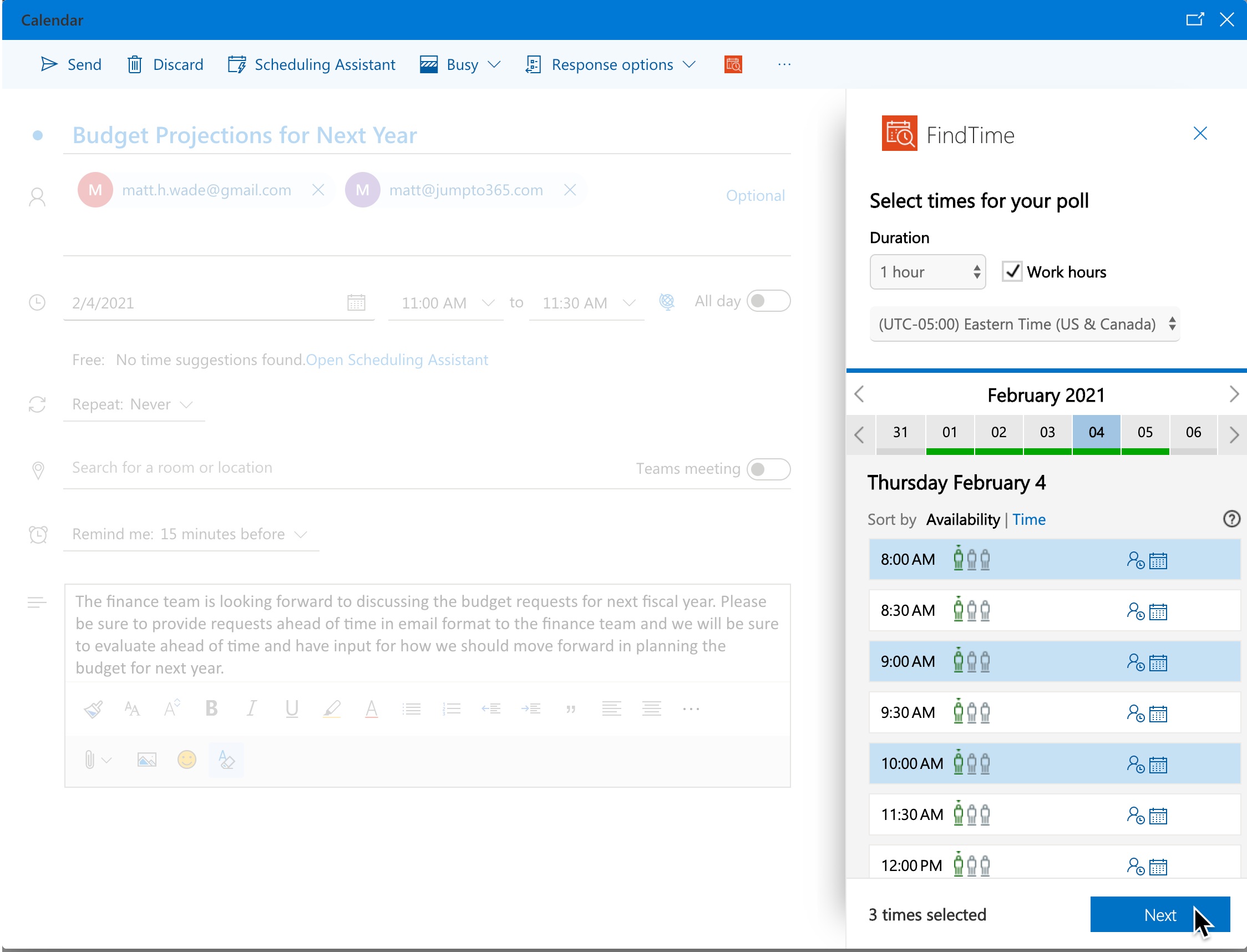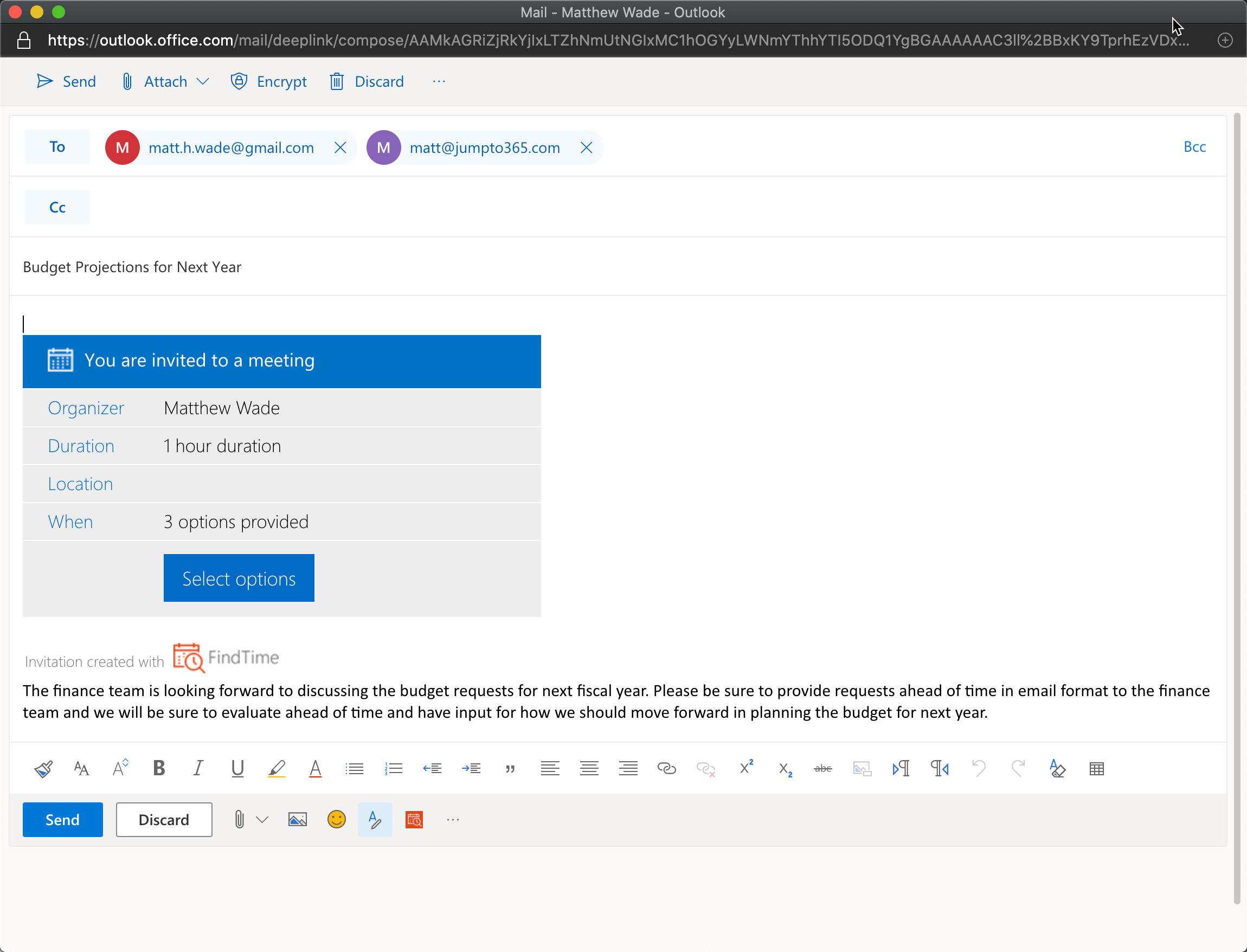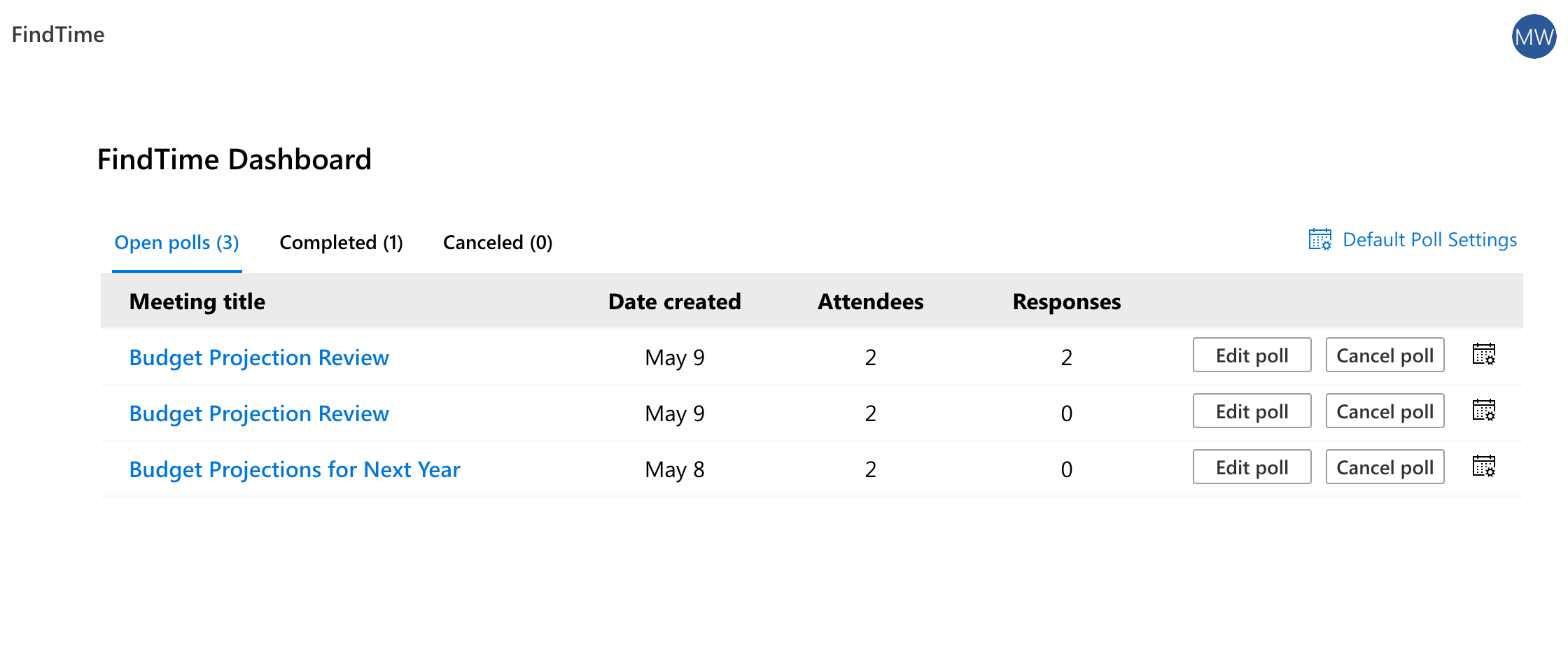FindTime is a fantastic way to schedule appointments with attendees whose schedules you don't have access to. So, any time you want to get going on a meeting with people outside your organization, FindTime is a great resource. If you've used doodle.com, it's a similar feature; except FindTime is created by Microsoft and has built-in integrations with Outlook and Teams. There are only a few steps to use FindTime. Here's how to do it.
Install the FindTime plugin
If you haven't used FindTime before, you need to install it to Outlook in your Office 365 account. Visit findtime.microsoft.com and install the plugin for your Outlook account in Office 365. If you run into issues, it's likely due to restrictions set up by your Office 365 administrator; reach out to your administrator or IT department and show them this article to justify you request to allow the FindTime plugin.
Create your FindTime poll
Once you're ready to set your FindTime poll, go to Outlook and click New event. Since the FindTime app is already installed, you should see a FindTime app icon in Outlook. This actually works best in Outlook on the Web (Online), so I'm going to use that as the example moving forward. FindTime works in Outlook for desktop as well, but I find that it works best in Outlook on the Web.
- Create a new event in Outlook's calendar.
- You must provide an event title and attendees.
- Click the FindTime icon (it might be listed under the ellipses to the right of the toolbar).

The FindTime pane will open on the right side of the new appointment. From here, you need to:
- Select the length of your meeting.
- Select the starting times of your meeting options. Ensure they can all match up with your current schedule. 🙂
- Starting times can overlap. An hour-long meeting selection could start at 8:00 am and 8:30 am.
- Including more options helps maximize the chance of everyone being available. There is a maximum of 20 times that you can select. Based on the number of people across time zones and with various priorities, I'm surprised this is the limit, but for now it is.
- Be acutely aware of time zones if that matters. You can use Google to check times in other times zones. For example, try Googling 4:00 pm EDT in CET.
- Click Next.

Next, you select some settings for the poll:
- You can select a location, e.g., a conference room in your system.
- Check the box for a Teams or Skype meeting. If you don't see a Teams meeting option, you need to talk to your IT admin for support. You need to be in Teams-only mode for that to work. Your IT admin will know what that means.
- There are three other options that are critically important for your scheduling:
- You can receive notifications when each person completes their poll. This is important because once the last respondent completes the poll, you'll be clear on being able to schedule the appointment.
- You can have FindTime automatically send an appointment that matches best with the responses. I find this to be a bit risky because you may provide a number of times that are okay with you, but there's no way to show preference for your own times. You may want to disable this so once the last respondent provides their preference, you can select from the options available that best match your attendees' preferences and yours.
- You can have FindTime set up a tentative appointment in your schedule for all of the options you provide to your attendees. This is a fantastic way to reserve the time on your calendar so nobody else in your organization books you at that time. Very important note: your attendees do not get the same benefit, so you want everyone to respond as soon as possible because even though they give their preference, their calendar is not reserved until you send an appointment later. I suggest including a line in the invite that says something like "please respond as soon as possible".
- Click Add to email.

Once you've set up the poll and clicked Add to Email, Outlook on the Web opens a new window that is an email (not an appointment!). Here you can add more text to the appointment. I usually move the appointment text above the poll so the recipients have some context. As long as you leave the FindTime table and links, everyone has the option click to view the poll and vote. Once your're done, press Send. Again, it's a regular email, not a meeting appointment. You'll receive responses as your recipients being voting.
Once you've sent the email, you will actually discard the original appointment you created. This is a bit of an inelegant requirement but I suspect it's because FindTime is a plug-in and not a native Outlook feature yet.

On the recipient's end
The invited attendee will want to click the Select options button in the email. If you're using an Office 365 account, the new page knows who you are; if you're using another account (e.g., GMail), you'll have to select which address you're responding for (choose yourself, not somebody else, please).
Next is a webpage where they can choose from the provided dates and times. Select from Yes, No, and Prefer. The Prefer option will have a heart attached to it when the scheduler gets the response. Click Vote and the sender will receive a notification of the selection (if they chose to get notifications for each respondent). It's a super easy experience for the recipient.

Note that if a recipient isn't available any time, your best bet is to propose another time. This can at least help the sender identify other times to choose from to meet your needs.
Keep in mind that your recipients need to respond as soon as possible. There is no appointment holding the spot in their calendar to reserve them for your time. So if they get booked after voting but before you send the appointment, that's a problem. There's no good solution to that. Theoretically, the recipient could drop a temporary appointment in each slot they chose, but that's likely asking much. That said, they should be aware that they're expected to respond very quickly.
Finalizing the meeting
Once everyone's responded, you'll get an email notifying you of that; it may take a little while for it to arrive. If you selected to have the appointment automatically sent, you'll actually have a new appointment and the former tentative appointments will have been deleted. If you chose to have a Skype or Teams meeting attached to it, that will be included automatically
Generally, I prefer to set up the meeting based on the responses. Some things benefit from human touch. In that case, you get an email with the responses. You will see which time slots where people are available and the ones that were preferred. To the right of the votes is a button to Schedule. A Teams or Skype meeting will be applied automatically if you selected that option.
Managing your FindTime polls
If you want to track your polls, all your polls are centrally located at your FindTime Dashboard located at outlook.office.com/findtime/dashboard. From here you can manage, edit, cancel, or delete your polls. You can also manage your default poll settings. Handy for if you have a number of them going at the same time.

Wrap up
FindTime is one of the best, mainly unknown tools available in Office 365. It has made meeting scheduling for me so much easier, especially among people in different industries and different time zones. If you're working with folks in different time zones, make sure when you pick your times, they're respectful to those times. For example, I live on the US east coast and have calls with people on the US west coast and Europe regularly. I have to stick to times around noon my time to ensure I can get everyone on without being super far out of regular work time. A little common sense and respect goes a long way.
There's another option for scheduling meetings. Outlook Scheduler, also known as Cortana and calendar.help, will schedule appointments using natural language. I'll cover that in another post.





Obviously you have an opinion, so share it!